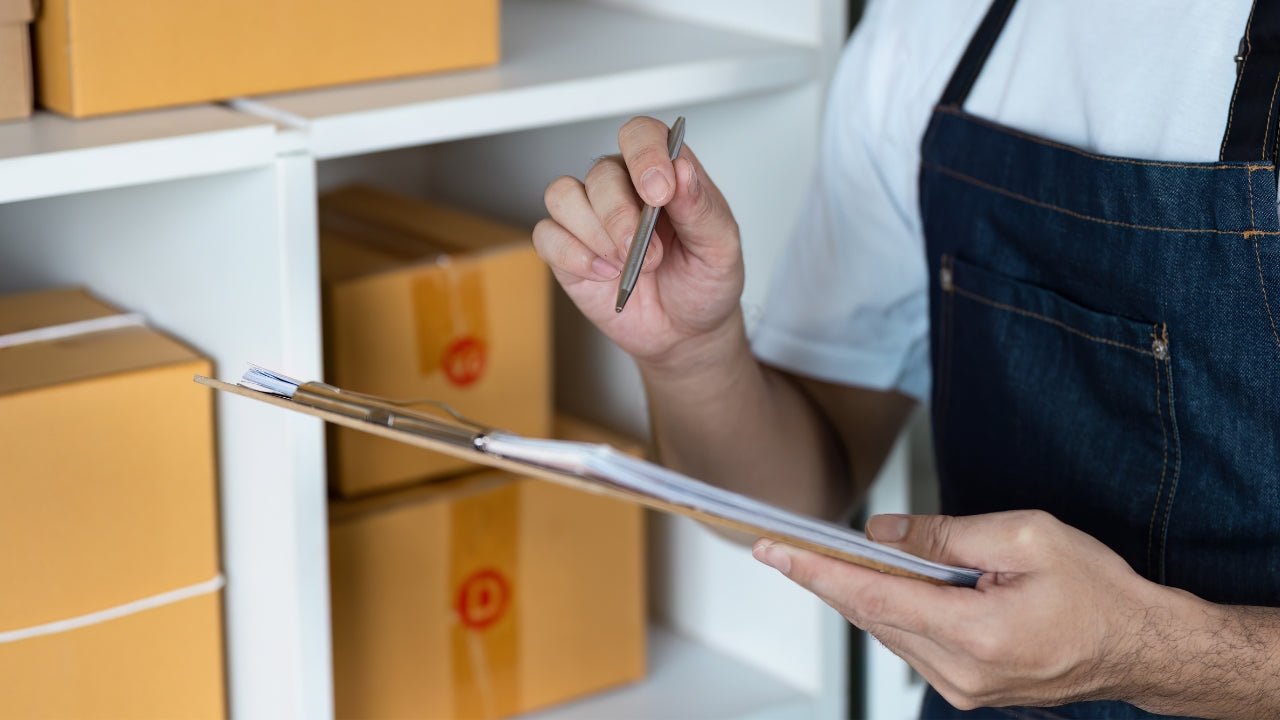
How to Boost Your Brand with Custom Shipping Labels & Ready-to-Use Templates
Lost packages, delays, and barcode issues? Learn how to print and apply shipping labels the right way!
Many of our clients struggle with shipping labels. They’re unsure whether to use templates, customize them, or which details actually matter.
We get it. When you’re running a small business, it’s easy to overlook labels. But they’re essential. Without a clear, accurate shipping label, packages can get delayed, lost, or sent to the wrong address, which can lead to frustrated customers and a damaged reputation.
And get this: 53% of online shoppers say delivery issues (delays, wrong address, or damage) negatively affect how they view a brand.
The right label helps avoid these headaches. In this guide, we’ll cover everything from shipping label templates to shipping label customization, so your shipping process stays smooth and stress-free.
What Should Be on a Shipping Label?
A shipping label needs a few key details to ensure your package reaches its destination quickly and safely. These include:
Recipient and Sender Details
Your shipping label needs two key addresses: where it’s going and where it came from. The recipient’s address makes sure the package gets delivered, and the sender’s address allows it to be returned if needed. A missing zip code or apartment number can cause major delays, so double-check before printing.
Tracking Number and Barcode
A tracking number and barcode let you and your customers follow the package’s journey. Every time it’s scanned, its location updates. If the barcode is unclear or damaged, scanning fails, and the package might get delayed. Make sure it’s printed clearly.
Shipping Method and Delivery Time
Packages move at different speeds: standard, expedited, or overnight. The shipping label tells carriers how quickly it needs to arrive. If a customer pays for express shipping, they expect it fast. Label it correctly to avoid delays.
Weight and Package Dimensions
Shipping costs depend on weight and size. If the numbers are off, you could face unexpected fees or delays. Accurate measurements can help you reduce shipping costs and keep things running smoothly.
Return Policy or Special Handling Instructions
Some shipments need extra care. Labels can include “Fragile,” “Perishable,” or “Do Not Bend” to ensure proper handling. If you offer returns, adding a prepaid return barcode makes it easier for customers and improves their experience.
Custom Shipping Labels vs. Shipping Label Templates
Shipping label template on Canva
Not all shipping labels are the same, and choosing between pre-made templates and customized labels depends on your business needs. Some businesses prioritize speed and efficiency, while others focus on branding solutions for small businesses and customer experience.
Here’s how to decide which option works best for you.
When to Use Shipping Label Templates
Shipping label templates are the quickest and easiest way to generate labels, especially if you’re shipping large volumes of orders daily. These templates come with pre-set fields for addresses, tracking numbers, and barcodes so that all necessary information is included and formatted correctly.
Use shipping label templates when:
- You need to print labels quickly and efficiently.
- You’re using carrier-generated labels from FedEx, UPS, USPS, or DHL.
- You rely on third-party fulfillment services like Amazon FBA or ShipBob, which require standard label formats.
- Branding isn’t a priority, and you just need functional, readable labels.
When to Customize Shipping Labels
A custom shipping label enhances your brand’s identity. If you want your packaging to leave a lasting impression, customizing your labels is a smart move.
Consider customizing shipping labels when:
- You want to include your logo, brand colors, or a slogan to reinforce brand recognition.
- You’d like to add a QR code that leads customers to your website, social media, or a special promotion.
- You’re shipping fragile or special items and need to include custom handling instructions.
- You want to personalize return labels with a message or easy return instructions.
Branded labels make your packages look more professional and memorable, helping you stand out from competitors. Even something as simple as a logo on a shipping label can make your business appear more polished and trustworthy.
Where to Customize Shipping Labels
If you decide to customize your shipping labels, there are several ways to do it, depending on the tools you use:
- E-commerce platforms – Shopify, WooCommerce, and BigCommerce let you add branding elements to your labels before printing.
- Shipping software – Tools like ShipStation, EasyPost, and Shippo offer more customization options, including batch printing for bulk orders.
- Carrier websites – FedEx, UPS, and USPS allow minor customization, such as adding a return address logo.
- Design software – For full creative control, you can design labels in Canva, Adobe Illustrator, or Photoshop, then print them using a label printer.
How to Create Shipping Labels
Now that you know when to use shipping label templates and when to opt for shipping label customization, let’s go through the process of actually creating one.
1. Using an E-Commerce Platform
If you sell through Shopify, WooCommerce, BigCommerce, or Etsy, you can generate shipping labels right from your order dashboard. Here’s how:
- Go to your orders page and select the order you want to ship.
- Click on the "Print Shipping Label" option.
- Choose your preferred shipping carrier and shipping speed.
- Download and print your label instantly.
This method is fast and beginner-friendly, especially if you’re shipping only a few orders per day.
2. Using a Carrier’s Website (FedEx, UPS, USPS, DHL, etc.)
If you prefer to purchase shipping labels directly from a carrier, you can create them on their official websites:
- FedEx Ship Manager (best for high-volume or international shipments).
- UPS WorldShip (ideal for businesses that use multiple UPS services).
- USPS Click-N-Ship (best for domestic shipping with flat-rate pricing).
- DHL Express Ship (for international shipments needing customs documentation).
Simply enter the shipping details, select a service level, and print the label from home.
3. Using a Third-Party Shipping Software
If you're handling bulk orders or want to compare carrier rates, shipping software like ShipStation, Shippo, or EasyPost can simplify the process. These tools let you:
- Auto-generate labels for multiple orders at once.
- Compare shipping rates across different carriers to find the cheapest or fastest option.
- Integrate with your e-commerce store for seamless order management.
This is the best option for growing businesses that need an efficient shipping workflow.
How to Print Shipping Labels
Printing your shipping labels might feel like a small step, but it makes a big difference in getting your packages where they need to go. A clear, smudge-free label means barcodes scan correctly and addresses are easy to read. If a barcode is faded or blurry, your package could get delayed or lost in transit.
If you’re shipping daily, a thermal printer is the way to go. Unlike regular printers, thermal printers don’t need ink or toner, which means fewer expenses and less maintenance. They’re fast, produce crisp barcodes, and work seamlessly with most shipping platforms.
The PrintPeak Ultimate Wireless Label Printer is a great choice for small businesses that need a reliable, high-speed printer. It’s wireless, so you can print labels directly from your computer or phone.
Plus, it’s compatible with major e-commerce platforms and shipping carriers, which makes integration easy. If you’re printing a high volume of labels, a dedicated thermal printer like this can streamline your workflow and help you avoid common issues like paper jams or smudged barcodes.
Also read: How Handheld Printers Are Transforming Small Business Operations
The PrintPeak Ultimate Wireless Label Printer in action
Shipping Label Best Practices
Printing a great shipping label is only half the battle. How you apply and handle it can make a huge difference. A misplaced, damaged, or unreadable label can slow things down, and no one wants that.
Here are some simple but effective tips to keep your shipments on track.
Keep Labels Flat and Wrinkle-Free
It might seem like a small thing, but a wrinkled or folded label can cause major issues. If the barcode gets creased, the carrier’s scanner might not be able to read it, which could delay your package.
Make sure your label sits flat on a smooth surface, and not over an edge or seam. A little extra care here goes a long way!
Use Waterproof or Adhesive Labels for Durability
Your package is going on a journey, and it’s not always a gentle one. It might get stacked in a warehouse, tossed onto a conveyor belt, or even exposed to bad weather. If your label isn’t durable, it could smudge, fade, or peel off.
Using waterproof or adhesive labels helps keep everything readable and intact, no matter what conditions your package faces.
Keep Barcodes Clear and Unobstructed
Barcodes are the key to tracking your shipment, so they need to be 100% visible. Never put tape over them, even if it’s clear tape, because glare can make scanning difficult.
Also, don’t fold or shrink the barcode to fit your label. Carriers rely on automated scanners, and any distortion could send your package into limbo.
Automate Label Creation to Save Time
If you’re still manually creating shipping labels, it might be time to switch things up. Most e-commerce platforms and shipping software let you generate, print, and apply labels in bulk, saving you time and reducing human error.
Automation helps keep everything consistent, so you don’t have to second-guess addresses or tracking numbers. More efficiency, fewer mistakes.
Offer Branded Return Labels for a Smooth Customer Experience
Returns are a part of e-commerce. But making it easy and hassle-free for customers can actually build trust and increase repeat purchases. Including a return label in the package (or letting customers generate one online) makes the process seamless.
Plus, when you add your branding to return labels, customers remember your business for the right reasons instead of getting frustrated with the return process.
Are You Ready to Print Your Shipping Labels?
Every business has its own set of technical details to figure out, and shipping labels are just one of them. But the good news? There are plenty of tools and software that make the process easier, like the PrintPeak Ultimate Wireless Label Printer.
Whether you’re using shipping label templates for quick setup or customizing labels to enhance your brand, you don’t have to do it all manually.
Once you get the hang of it, printing and applying shipping labels will feel like second nature. With the right setup, you’ll save time, avoid shipping headaches, and keep your customers happy. Ready to start? Let’s get labeling!



